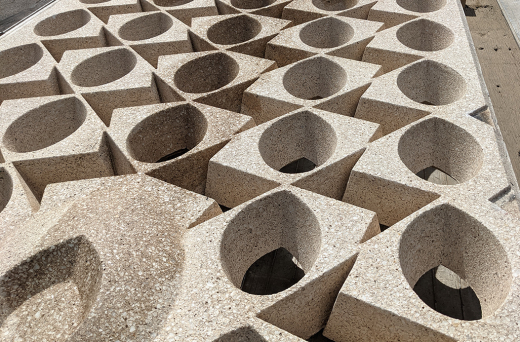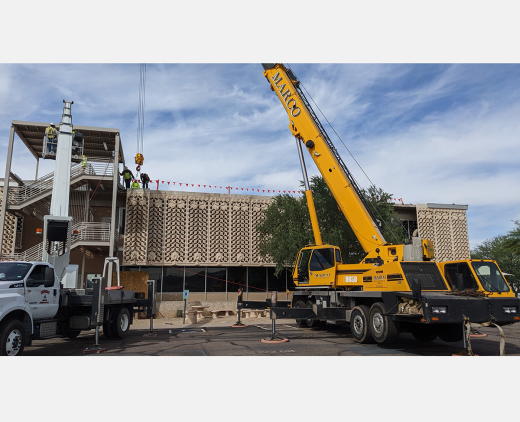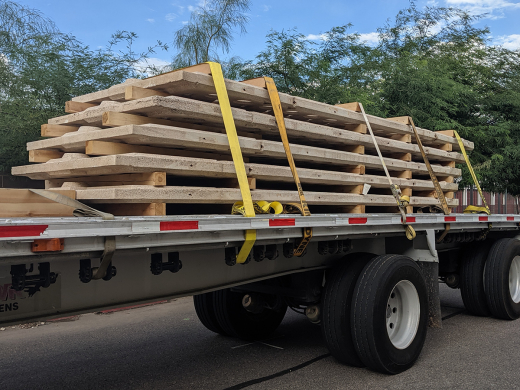Architect Fred Guirey moved to Arizona after graduating with an architecture degree from the University of California-Berkeley in 1933. His parents had already relocated to Tucson for health reasons, and he had frequently visited the state for jobs, including helping engineer the road from Jacob Lake to the North Rim of the Grand Canyon in 1930.
For nine years, Guirey worked as a landscape architect with the Arizona Highway Department, eventually becoming a director and acquiring the nickname, "The Father of Our Roadside Rest Areas." He and his wife, Catherine “Tat” Bolen, were active in the community and threw elaborate parties at their home at 300 East Missouri Avenue. Guirey started his own firm in partnership with Stan Quist in 1946. By 1961, after going through several more iterations, the firm was known as Guirey, Srnka & Arnold. Guirey designed the architectural group’s office at 506 East Camelback Road in 1952.
Guirey and his associates had designed homes, schools, and other buildings when they received the commission in 1961 to be the architect for the Arizona Public Service (APS) administrative building in Deer Valley at 2124 West Cheryl Drive. Frank Foltz & Associates were the project’s structural engineers, while Johannessen & Girand were the consulting engineers.The most noteworthy feature of the building was the precast concrete panels attached to the exterior and used to shade the entire glass façade, including an entry walkway. The panels feature flame and lightning motifs, appropriate for a power company. “They’re amazing designs and drawings, to say the least,” Trahan says.
How to save 165 tons of precast concrete panels
Author
Douglas Towne
Affiliation
Journalist and historian
Tags
Over the next 60 years, several panels over the walkway developed hairline cracks, making them a safety hazard. So, with safety in mind, APS had those panels removed. When APS decided to renovate its building, they found that replicating the damaged panels would be prohibitively expensive. "They decided to create an aluminum composite on the exterior instead of new pre-cast panels," Trahan says. Unfortunately, that made the remainder of the precast concrete panels expendable, and the landfill became a likely final destination.
Alison King, the founder of Modern Phoenix, was the first to hear of the panels' fate. The decision to remove the screens had already been made. Ryan Ferguson of McCarthy Building Companies, a local builder on the project, recognized their significance and reached out to see if there was any interest in re-use. “It’s not uncommon for Modern Phoenix to be contacted by total strangers who are interested in saving Modern cultural resources,” says King. “But when I heard about the scope of the screen removal and wrapped my head around how heavy and technical the screens would be to remove, I had to think about who could step in and coordinate such a large-scale rescue.”
“For security reasons, the APS campus is gated and closed to the public. So the average citizen can't just walk up and experience this architecture for themselves,” says King. “Many Modernism enthusiasts didn't even know these panels existed or have only seen them in photographs! They were custom-crafted specifically to stand as an expression of APS’ role in providing utilities to an exploding metropolis. The flame motif is especially clever as a subtle reminder of their service.”
King had to act quickly, as removal was described as imminent. Having an affinity for Phoenix’s impressive midcentury architecture may come easily for many in the construction industry, but performing the dirty work of preserving this unique heritage requires a tad more passion, especially when the task requires moving 325,000 pounds of delicate precast concrete.
Fortunately, one firm stepped up who had both the enthusiasm for architectural panels and a skilled crew capable of salvaging them, 180 Degrees Design + Build. James Trahan, AIA, principal and partner, explained, “Our work not only kept some of Phoenix’s irreplaceable mid-century architectural heritage out of a landfill but provides our company the opportunity to reuse them in new projects around the Valley.” After being contacted by King, Trahan then reached out to David Ramirez, an APS Project Manager for APS Facilities Design & Construction, about salvaging the panels, and told him, “We’ll take as many as you don’t want!”
In the end, 180 Degrees Design + Build collected 86 panels, each weighing 3,800 pounds, while APS retained around 20 panels for use around their building. Team members including Evan Emery, Mikhail Gladchenko, Casey Fowler and Jesus Carillo craned the panels off and layered them on a flatbed truck, ensuring they were safely stored awhile waiting their next life. Desert Services coordinated the removal of the panels from the building, and Marco Crane & Rigging also provided their expertise and experience.
Currently 25-30 panels are reallocated for use on a project for Elite Family Service located in Chandler, AZ. 180 Degrees hope to utilize the others in future jobs (if you happen to know of any projects these might be a good fit for – please reach out to James Trahan at jtrahan@180degreesinc.com.)
Asked what it was like to preserve 165 tons of mid-century heritage, Trahan says, “It was an expensive operation even though the panels were free.” For years, Trahan has served on the Rio Salado Architecture Foundation’s Archives Committee. Typically, the committee conserves and archives architectural drawings of prominent Arizona architects, but these panels were entirely different in scale. The mission, however, was the same, to salvage our architectural heritage at any expense.
About the Author
Douglas Towne, a journalist and historian, has served as editor of Arizona Contractor and Community magazine since 2012, and the Society for Commercial Archeology Journal since 2004. He has contributed more than 100 stories to PHOENIX magazine since 1997 and has written a monthly history column for The Arizona Republic since 2015. Doug’s works have also appeared in a variety of other publications, including the Journal of Arizona History, Modern Phoenix, Phoenix Home & Garden, IKEA's Space, Downtown Phoenix, Phoenix New Times, and Route 66.





